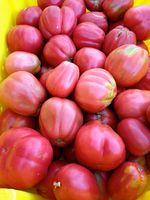Ayers Creek Farm Newsletter August 24 2014
When the bell chimes Sunday morning at 10:00 AM, you will find the following botanical bounty at the Hillsdale Farmers' Market:
Berries: Astiana tomatoes, tomatillos, table grapes -- It was fun to watch Greg Higgins and his staff try to fit "A g Astiana tomatoesrape with no name" on the written menu. The alternative was what Jack calls them: Anthony grapes. The former held sway. Remember, grapes are wonderful in savory dishes, as well as in the fruit bowl.
Astiana tomatoesrape with no name" on the written menu. The alternative was what Jack calls them: Anthony grapes. The former held sway. Remember, grapes are wonderful in savory dishes, as well as in the fruit bowl.
Compound Fruits: the very last of the Chester Blackberries for 2014. The farewell round of this now very delicate fruit.
Drupes: green gages, Seneca prunes and la mirabelle.
Bulbs: onions & garlics
Grains: popcorn, frikeh and cornmeal
Legumes: favas
Pepos: cucumbers & summer squash
Thursday, All Crop #67208 had her first outing in decades. With the large wooden straw rack swaying side-to-side, her gait has a touch of the rumba in it. She filled bags of hulless barley effortlessly, and we should have some cleaned and at the market within a week or so. The challenge of having her ready for Will and Jon's visit was met, and Will can tell you all about this amalgam of canvas, wood and steel at the market next week.
Sotweed, Spuds and Tomatoes
Harvesting tomatoes leaves your hands and arms covered with plant resin that has a fragrance instantly recognizable to anyone who grew up around a pipe smoker, that of fine burley tobacco. Tomatoes and tobacco, also called sotweed, are both in the nightshade family, along with potatoes, tomatillos and peppers.
The Sotweed Factor, John Barth's novel set largely on the Eastern Shore of Maryland, refers to a traveling agent, a factor, who purchased tobacco from farmers. Like Barth, Carol's father, Peter Black, had a deep affection for the Eastern Shore, both for its history, landscape and nature, as well as its natural affinity for scoundrels. His country hams, smoked and dried for seven years or more, sliced as thin as paper and served on beaten biscuits, are missed as the holidays roll around, along with Thelma Johnson's persimmon pudding and, earlier in the year, the soft shell crabs. The blue crab is of its own kind and should never be compared to its sweeter West Coast cousin.
One evening, as we enjoyed the cool breeze that came down Plain Dealing Creek and through the well-placed house surrounded by old pecan trees, we talked about another of Barth's novels when Peter digressed, explaining to us the second meaning of the "sotweed factor." Tobacco is an extractive plant, feeding heavily on the land and required a seven-year rotation between crops. Thus a tobacco grower seeking to harvest an acre of tobacco a year needed seven acres total, a factor of seven. With care, other cash crops could be grown in the rotation, but building the soil for the next crop of tobacco was paramount. The farmer could grow on a shorter rotation, but the leaf lost its aromatic quality and flavor and was considered worthless. The human factor would decline to purchase it.
Closely related to tobacco, potatoes and tomatoes share this trait. One year, we foolishly followed a crop of tomatoes with potatoes and they were the worse spuds we ever pulled out of the ground, absolutely flavorless and unfit for our discerning customers. Diagnosing the failure, we recalled Peter's discussion about the sotweed factor, and now we make sure we keep seven years between crops in the nightshade family. Other crop plants show a similar propensity, though not as aggressive. Processors require three years between crops of sweet corn for the same reason; shorter interval result in less flavorful corn.
As a general matter, it is a good idea to separate similar crops by several years. We also heed the Biblical instruction to leave the land fallow every seven years, though we are not strictly observant when it come to the exact frequency. The fact is, land needs an occasional rest. Until the middle of 20th century, a fallow year was included as a matter of course in crop plans. Not only does the soil rest, allowing it to refresh its mineral availability, the fallow also creates a break in pest and disease cycles. We had an email exchange with youngish organic farmer who was growing several crops of greens each year with good success for about five years, and suddenly she started having disease problems. We recommended a fallow year. Conventional growers can address those disease and insect problems with chemicals, but the flavor and quality of the fruits and vegetables still declines with intense crop cycles.
The other day, with our spuds not yet ready to harvest, we cooked up some fine looking Brand X certified organic potatoes and they were as bland as bland as can be, reminding us of the nasty crop we erased with a plow many years ago. Organic growers cannot produce a good crop, even if they avoid disease and pest problems, if they insist on throttling down on the rotation and never leaving the land to rest. True, variety selection and the cultivator's competence are important as well, but they are for naught if the need for rotation is ignored. And on the seventh year, the land shall rest.
We will see you all Sunday,
Carol and Anthony Boutard